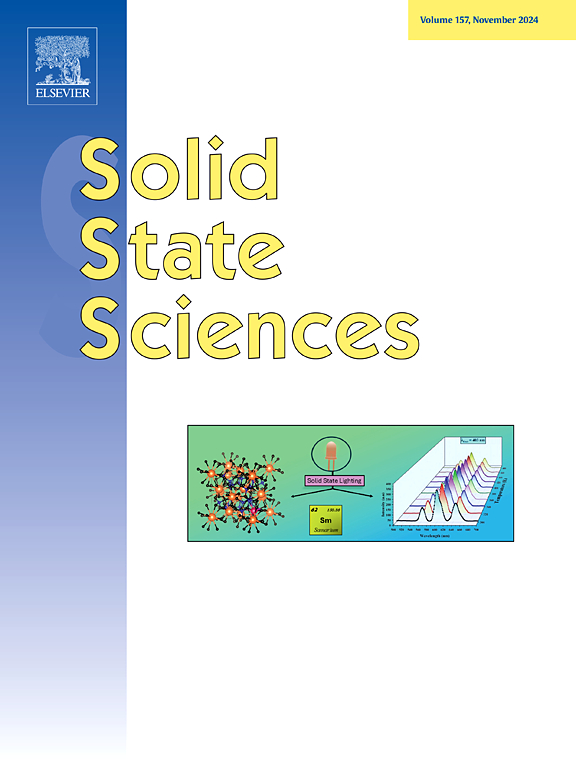Seed-assisted synthesis of ZSM-5 nanozeolites with high catalytic activities for cracking oleic acid to light olefins and light aromatics
IF 3.4
3区 化学
Q2 CHEMISTRY, INORGANIC & NUCLEAR
引用次数: 0
Abstract
A series of nanosized ZSM-5 (SNZSM-5) zeolites has been synthesized by the seed-assisted method using silicalite-1 as seeds. Catalytic cracking of oleic acid to produce light olefins and light aromatics using SNZSM-5 as the catalyst was performed using a laboratory-scale fixed-bed reactor. The effects of the crystallization time and Si/Al molar ratio on the morphology and multilamellar structure of SNZSM-5 were studied to reveal how these properties affect the catalytic performance. Scanning electron microscopy, transmission electron microscopy, X-ray diffraction, temperature-programmed desorption of ammonia, and N2 physisorption and desorption were performed to characterize the morphological features, acidities, and pore structures of the SNZSM-5 nanozeolites. Compared with conventional ZSM-5 zeolite, the SNZSM-5 nanozeolites possessed smaller particle diameters (90–450 nm), and they thus contained more intercrystalline voids. The Brunauer–Emmett–Teller surface areas (211–309 m2 g−1) and mesopore volumes (0.08–0.27 cm3 g−1) were both higher than those of ZSM-5 zeolite. Moreover, owing to the larger specific surface areas of the nanocrystals, more acidic sites can be exposed. Therefore, the SNZSM-5 nanozeolites showed higher catalytic activity and stability than conventional ZSM-5. The catalytic activity could be sustained for up to 35 h. Under the conditions of a reaction temperature of 500 °C, an oleic acid flow rate of 0.04 mL min−1, and a nitrogen flow rate of 30 mL min−1, the SNZSM-5 nanozeolite prepared with a Si/Al molar ratio of 16 showed the highest catalytic activity, producing up to 67 % yield of light olefins and showing 14.5 % selectivity for light aromatics.

种子辅助合成具有高催化活性的ZSM-5纳米沸石,催化油酸裂解为轻烯烃和芳烃
以硅石-1为种子,采用种子辅助法制备了一系列纳米ZSM-5 (SNZSM-5)分子筛。在实验室规模的固定床反应器上,以SNZSM-5为催化剂,进行了油酸催化裂化生产轻烯烃和轻芳烃的实验研究。研究了结晶时间和Si/Al摩尔比对SNZSM-5的形貌和多层结构的影响,揭示了这些性质对催化性能的影响。采用扫描电镜、透射电镜、x射线衍射、程序升温解吸氨、N2物理吸附和解吸等方法对SNZSM-5纳米沸石的形态特征、酸度和孔隙结构进行表征。与传统的ZSM-5分子筛相比,SNZSM-5纳米分子筛具有更小的粒径(90 ~ 450 nm),因此含有更多的晶间空隙。brunauer - emmet - teller分子筛的表面积(211 ~ 309 m2 g−1)和介孔体积(0.08 ~ 0.27 cm3 g−1)均高于ZSM-5分子筛。此外,由于纳米晶体的比表面积较大,可以暴露更多的酸性位点。因此,SNZSM-5纳米沸石比传统的ZSM-5具有更高的催化活性和稳定性。在反应温度为500℃、油酸流量为0.04 mL min - 1、氮流量为30 mL min - 1的条件下,Si/Al摩尔比为16制备的SNZSM-5纳米沸石的催化活性最高,轻烯烃收率高达67%,对轻芳烃的选择性为14.5%。
本文章由计算机程序翻译,如有差异,请以英文原文为准。
求助全文
约1分钟内获得全文
求助全文
来源期刊

Solid State Sciences
化学-无机化学与核化学
CiteScore
6.60
自引率
2.90%
发文量
214
审稿时长
27 days
期刊介绍:
Solid State Sciences is the journal for researchers from the broad solid state chemistry and physics community. It publishes key articles on all aspects of solid state synthesis, structure-property relationships, theory and functionalities, in relation with experiments.
Key topics for stand-alone papers and special issues:
-Novel ways of synthesis, inorganic functional materials, including porous and glassy materials, hybrid organic-inorganic compounds and nanomaterials
-Physical properties, emphasizing but not limited to the electrical, magnetical and optical features
-Materials related to information technology and energy and environmental sciences.
The journal publishes feature articles from experts in the field upon invitation.
Solid State Sciences - your gateway to energy-related materials.
 求助内容:
求助内容: 应助结果提醒方式:
应助结果提醒方式:


